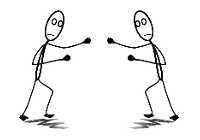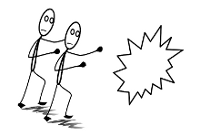Conflict Modes
The following ideas are based upon the work of Kenneth Thomas and Ralph Kilmann, who developed the model of five different conflict modes. In every conflict situation a person has the option to compete, to avoide, to accomodate, to compromise or to collaborate.
Click on the question marks to learn more about a particular mode.
Transforming conflicts into problems
In a conflict both sides consider the other side to be opponents, each defending his/her interests and trying to gain greater benefits for himself/herself. Each side is fighting the other.

The preferable situation is that both sides see each other as allies trying to find a solution to a common problem. In this picture both sides sit on the same side of the table and fight the problem together.

“I messages” versus “You attacks”
As in the feed back process (see above), it helps to avoid You attacks, e.g. “You did this and that” or “Your actions caused this.” Such attacks can easily be experienced as insulting and humiliating, resulting in opposition or retreat. A well formulated I message will include information about the observed action, what it did to the speaker, and what were the consequences, e.g. “Peter, the idea you propose makes me angry because I get the impression that you do not care enough about this task.”
Positions and needs
According to systemic theories, in a conflict situation one can differentiate between expressed positions and underlying needs.
Example: Director: “You haven’t prepared the requested progress report again!”. Teacher: ”Well, if I would spend as much time as is required to deal with all these reports, I would not have any time left to prepare for my teaching!”
If the discussion is continued on this level – the Position level — it will be difficult to find a resolution that satisfies both sides; it is much more likely that the situation will escalate into a hidden or open conflict. But by drawing attention to the underlying needs of each position, it is possible to move the conflict into a constructive setting.
| Director | Secretary | |
|---|---|---|
| Positions level | Report not prepared. | Not enough time. |
| Needs level | Needs the information for his work; trust in teacher; efficient work flow. | Direct tasks seem more important than bureaucratic requirements; work overload. |
Yes, but
When being wrongly criticised, one way of transforming the conflict into a constructive situation is to swallow one’s pride, accept the criticism, and then invite the other to help find a solution.
Example: During the course a participant criticises the teacher for not giving him/her enough time for sharing his/her experiences. Though the teacher feels that this is an unfair criticism, he/she responds: “Sorry for that! Maybe you have some ideas for how we can balance the requirements of the curriculum with the desire for exchanging experiences and opinions?”
Acting in such a way is often difficult because being wrongly criticised can hurt greatly and this approach requires the person to neglect his/her self-respect. But in situations where it is more important to obtain a result than to work on interpersonal relationships this is an effective tool. This tool ignores the Relationship level of the message and requires the other side to engage in a constructive way in the search for a solution.
The role of the teacher (leader) in a conflict situation
The following information is placed in a teaching setting, but the same principles are valid also in other group settings.
1. Conflict between participants and the teacher
If a conflict arises between the teacher and a participant, e.g. a participant starts provoking the teacher, refuses to take part in a task, or disturbs the work of other participants, it is important to keep a cool head and assess the situation.
Some tips:
- The communication principles and tools described in this section can help to transfer the focus from an emotional level to a rational level, e.g. considering the four sides of communication, differentiating between needs and positions, and following the rules for giving feed back.
- Assess what is more important at this stage: a positive atmosphere in the group or the content of the course.
- Try to avoid getting into one-on-one confrontations with a participant because this will transform the classroom into a theatre with you and the participant fighting on the stage and everybody else watching with great interest who will come out on top. Instead, you should try to involve the group in the process. For example, in the previous example the teacher could include in the whole group in his/her response by asking if other participants also feel the same way.
- Accept that there will almost always be some dissatisfied participants. By focusing too much on addressing the needs of a few persons the teacher may potentially lose the remainder of the group.
2. Conflict between members of the group
If a conflict arises between members of the group, the following recommendations from P. Wellhöfer provide a good guideline for the teacher.
1. Avert the threat. Do not allow participants to lose their patience, become aggressive, retreat, or create chaos:
- Intervene energetically.
- Emphasise the common goal.
- Remind the group of the rules.
- If necessary, change your own positions.
2. Formulate or let the group formulate what the conflict is about:
- Call a spade a spade.
- Do not deviate but try to resolve the conflict.
- Ask the group to give a summary of what happened that led to the conflict.
3. Listen to and observe what participants are saying regarding the conflict. Ask questions and urge the group to focus on how to continue:
- Organise the information, positions, statements.
- Differentiate between relevant and irrelevant aspects.
- Give suggestions for resolving the conflict.
- Focus on long term aspects, invite the group to take on responsibility.
- Prevent deviation from the topic.
4. Summarise in order to show the participants:
- How you have understood things.
- Where there are obvious contradictions.
- How you try to analyse and structure the situation.
5. Give your own opinion. If at all necessary, only now you should present your opinion regarding the situation:
- Comment, praise, criticise.
- Make decisions.
- Announce information.
- Offer your suggestions.


